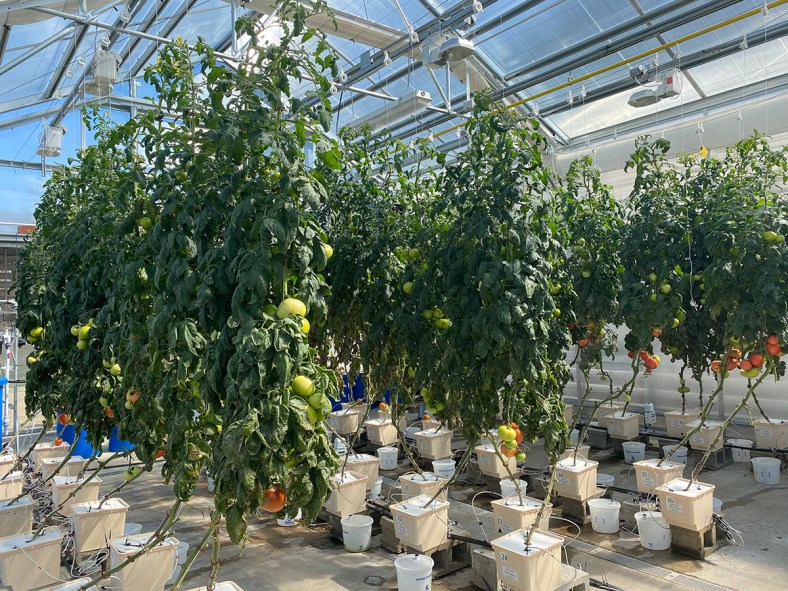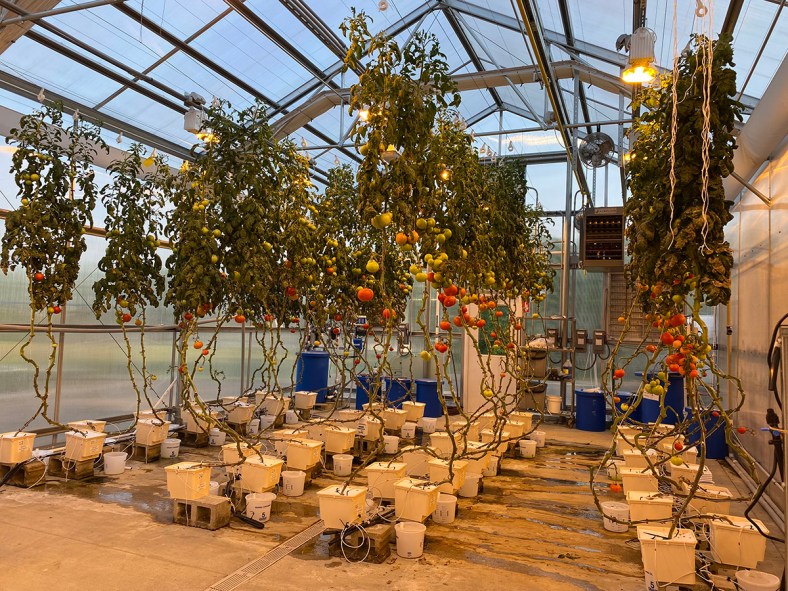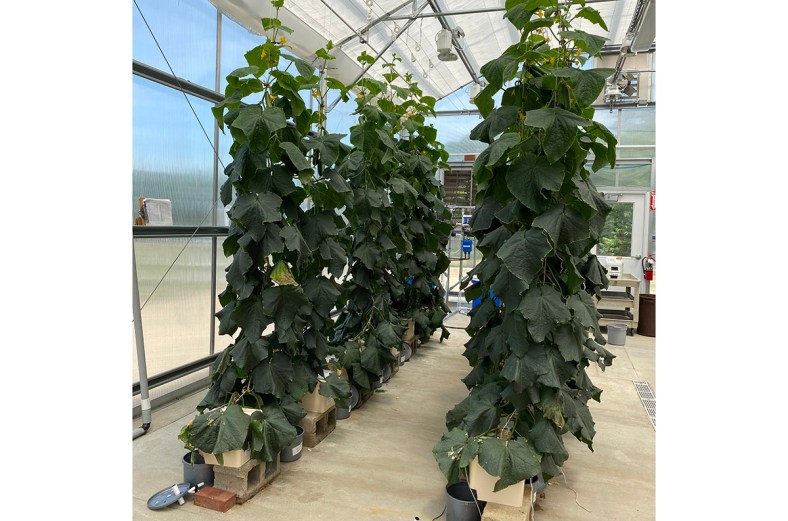The amount of leachate from cucumber plants grown in Dutch buckets can be significantly reduced with plant-based substrates when compared to perlite.
Photos courtesy of Uttara Samarakoon, Ohio St. Univ., CFAES Wooster
Growers using containers to produce vegetable crops have options when it comes to growing in plant-based substrates.
Small- to medium-size growers of vining vegetable crops including cucumbers and tomatoes have traditionally used Dutch buckets filled with perlite as the growing substrate. While some growers may be concerned with the sustainability of perlite because of disposal issues, there are options when it comes to using alternative plant-based substrates.
Improving sustainability of controlled environment production
Uttara Samarakoon, who is associate professor and program coordinator for greenhouse and nursery management at Ohio State University, CFAES Wooster, has been studying ways controlled environment growers can improve sustainability of containerized vegetable production. Samarakoon is working with Teng Yang, a post-doctoral researcher at Ohio State University, CFAES Wooster, and James Altland, research leader Application Technology Research, USDA-Agricultural Research Service in Wooster. Their research is being funded by USDA-ARS.
“The main theme of my research program is on sustainability for controlled environment agriculture,” Samarakoon said. “The research we are currently doing focuses specifically on high wire crops, including cucumbers and tomatoes, produced in Dutch bucket systems.
“My experience when visiting small- to medium-size vegetable growers is that many of them are using perlite as the substrate in Dutch bucket systems. In addition to concerns with disposal issues for perlite, it also has a low water-holding capacity resulting in higher rates of leachate. I have been using perlite in my research for some time because that is the traditional substrate for Dutch buckets.”
Dutch buckets are not the common production system used in most large-scale controlled-environment vegetable operations.
“Large-size vegetable operations tend to use hanging gutters with rockwool or coir slabs for high wire crop production of cucumbers, tomatoes and peppers,” Samarakoon said. “Recirculation of the fertilizer solution occurs primarily with large-scale commercial growers. Most small- to medium-size growers don’t have the capacity to do recirculation.”

Identifying alternative substrates
Although Dutch buckets are primarily used for growing vining crops, Samarakoon said this method of production is very similar to other types of containerized crop production. Even though the alternative substrate trials she conducted used Dutch buckets, she said the findings from her studies can be applied to any type of containerized crop production.
When Samarakoon was selecting substrates to compare with perlite she considered both sustainability and availability. In the first trial with cucumber, the researchers chose plant-based substrates, including sphagnum peat moss, two different grades (medium and course) of pine bark, coir and wood fiber (HydraFiber). All of these substrates were trialed against perlite, which was used as the control.
For the study, Dutch buckets were filled with 100 percent of each of the substrates.
“Our key finding was growing cucumbers in Dutch buckets, the amount of leachate can be significantly reduced with any of these plant-based substrates compared to perlite,” Samarakoon said. “The sustainability of this production system can be increased by using any of these alternative substrates. Although the substrates we trialed were not certified organic, there is the potential for growers to use similar substrates that are certified organic.”
The researchers found there was no difference in terms of time to fruiting and number of cucumbers produced regardless of the substrate trialed. One difference that occurred with medium-grade pine bark was an increase in fruit weight compared to perlite. However, the fruit weight of plants grown in medium-grade pine bark was similar to the other plant-based substrates.

Tomatoes in alternative substrates
Based on their success with cucumber, Samarakoon and the other researchers looked to repeat the study with tomatoes grown in the plant-based substrates. For these trials the Dutch buckets were filled with 100 percent sphagnum peat moss, medium-grade pine bark or wood fiber with perlite again as the control under two different irrigation regimes. The response was similar to cucumber with the number of fruit and individual fruit weight in plant-based substrates compared to perlite. Irrigation rates used did not influence the yield except in peat.
“The leachate rates were different among the substrates throughout the crop production with perlite having the highest amount of leachate,” Samarakoon said. “Therefore sphagnum peat moss, medium-grade pine bark or wood fiber can replace perlite without any yield reduction and the added advantage of reduced leachate for both cucumber and tomato.”
The tomato trial ran for 20 weeks until the plants reached the top wire support.
“We did not grow the tomatoes beyond that stage because it would have required lowering the vines and that could affect the type of data we collected,” Samarakoon said. “In our next tomato trial we will be using the same substrates but growing the plants in a nine-month production cycle. We will be lowering the vines and training them to continue growing for a nine-month production cycle in order to determine how the alternative substrates sustain the plants. We are also focused on optimizing the propagation of vine crops when using alternative substrates.”
For more: Uttara Samarakoon, Ohio State University, CFAES Wooster; samarakoon.2@osu.edu; https://ati.osu.edu/uttara-samarakoon-phd.
This article is property of Urban Ag News and was written by David Kuack, a freelance technical writer in Fort Worth, Texas.


